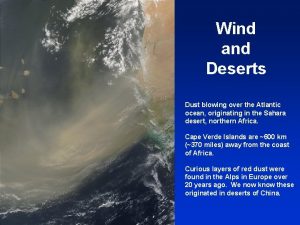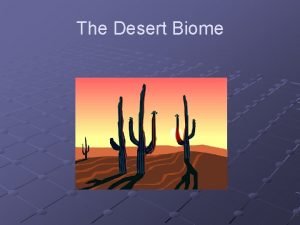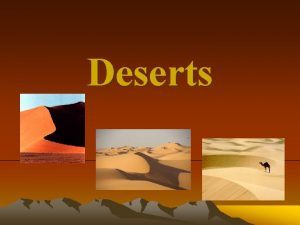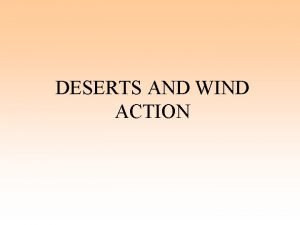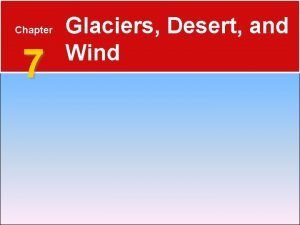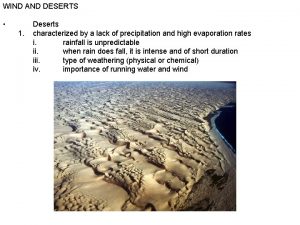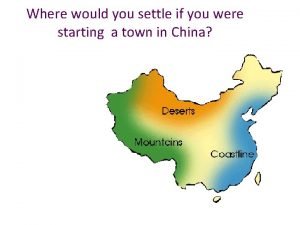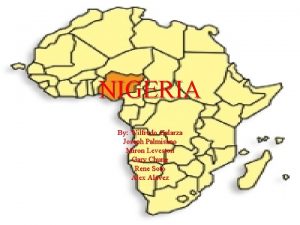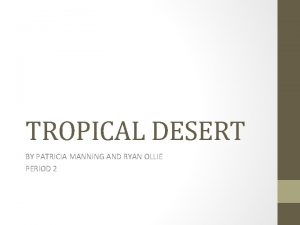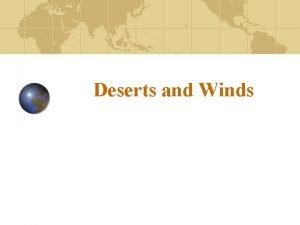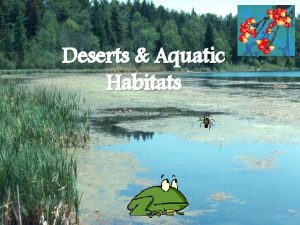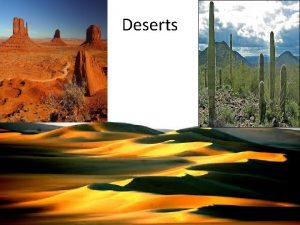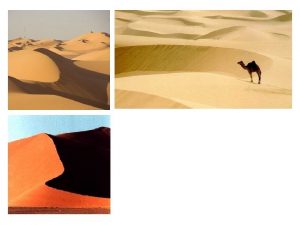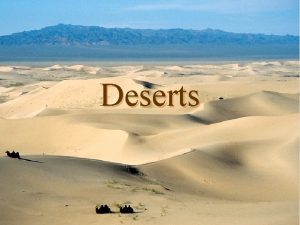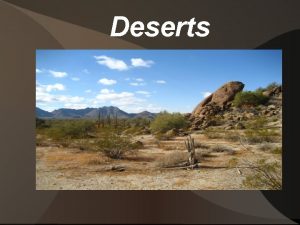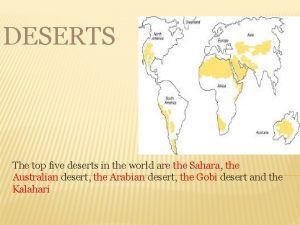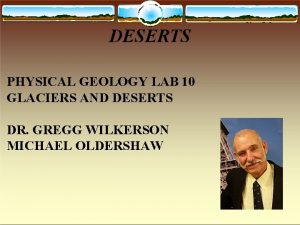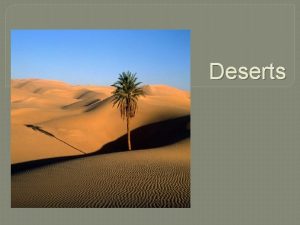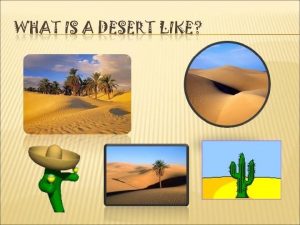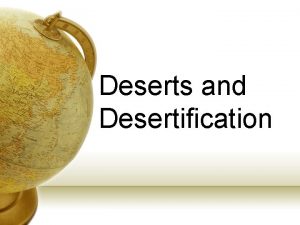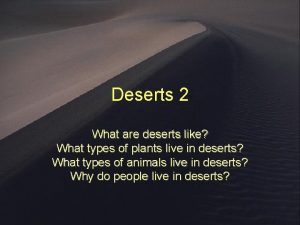Lecture 16 Deserts Definition of Desert A desert






















































- Slides: 54

Lecture 16 - Deserts

Definition of Desert • A desert is an area with less than 25 cm (10 inches) of annual precipitation • aridity index = potential evaporation/precipitation greater than 4. 0 • Deserts may be cold, temperate or hot. All major continents have one type of desert or the other.

Wind-Swept Sand Dunes

Desert Life Forms (Roadrunner)

Desert Life Forms (Lizard)

Types of Deserts • Desert Types - Subtropical Desert – 30 o Latitude - Deserts on Leeward side of major Mountain ranges - Interior Deserts- center of continents far from ocean - Coastal desert- prevailing onshore wind cooled by cold ocean current - Polar deserts- extremely cold and dry

Coriolis “turns” them The major wind cells

Subtropical Deserts +/- 30 o latitude

A Rain-Shadow Desert

Ocean-Current Desert

Also Interior and Polar Deserts

Desert Landscape (Features) Weathering and desert streams create Desert features • Weathering in Desert is mostly mechanical - A little chemical weathering produces manganese and iron-oxide stains, called desert vanish • Stream Erosion - Arroyo- channel with water during periods of high discharge but dry most part of the year - Pediments- large-scale gently inclined surfaces - Inselberg- steep-sided knob of durable rock - Playa- dry lake bed

Chemical Weathering in Deserts

Desert Landforms Produced By Water

Uluru (Ayers Rock) Inselberg

Playas

Playas (cont'd)

Playas (cont'd) – A Playa in Death Valley, California

Swimmers in hypersaline Dead Sea Evaporite deposits indicate a dry climate in the geologic record

Water-Carved Canyon

Work of Winds • Erosion by Wind - Deflation- wind removes finer particles from the surface - Desert pavement- layer of pebbles left behind after deflation - Abrasion- sand blasting - Ventifacts- wind-shaped stones with sharpedge faces - Yardangs- streamlined desert ridges

Blowout Caused by Deflation

Desert Pavements

Desert Pavements (cont'd)

Desert Pavements (cont'd)

Desert Pavements (cont'd) – These make good landing strips Source: Martin Miller

Desert Varnish slows infiltration Causes Flash Floods

Remnants of Wind Abrasion in addition to occasional flash flood erosion (surface grains are frosted)

Origin of Ventifacts

Origin of Ventifacts (cont’d) Wind

Yardangs , White Desert, Egypt

Transport By Wind • No dissolved load • Suspended Load- most consist of dust (silt, clay, pollen, bacteria, salt crystals, etc. ) • Bed Load- sediments moved along or near the ground – Rolling or saltation- bed loads lifted off the ground momentarily due to force of collision with other grains

Transport of Wind-Borne Sediment Suspended Load Transports Sahara sediment to Caribbean and Amazon Rain Forest

Deposition of Dunes • Reduced wind velocity results in sediments deposition • Dunes are hills of loose wind-born sand - Size, shape, and orientation of dune are determined by available sand, vegetation, and wind

Beach Sand Dunes

Deposition of Wind’s Bed Load Rain – Shadow Desert in Lee Of Mountains

Large Scale Dunes (Gobi Desert)

Dune Migration Just like ripples in a stream

Dune Migration (cont'd)

Deposition and Dune Types • Dune Types - Transverse- ridges that are perpendicular to prevailing wind direction - Longitudinal- ridges that are parallel to prevailing wind direction - Barchans- crescent-shaped with horns pointing downwind - Horseshoe (Parabolic)- crescent-shaped with horns pointing upwind - Star- winds from three or more directions

Transverse Dunes

Transverse Dunes

Longitudinal Dunes

Longitudinal Dunes

Barchan Dunes

Barchan Dunes in Baja California

Parabolic Dunes

Star Dunes

Star Dunes

Lithified Sand Dunes (Jurassic Navajo Sandstone)

Loess • Loess formed by windblown deposits of glacial outwash silt Loess from the Columbia River Basin

Desertification • Desertification- invasion of desert conditions into formerly non-desert areas • Drought and overpopulation are main causes • Signs - Lowering of water table - Marked reduction of water supply - Increased salinity in water and soil - Progressive destruction of native vegetation - Accelerated soil erosion

Map of the Sahel

End of Lecture 16
 01:640:244 lecture notes - lecture 15: plat, idah, farad
01:640:244 lecture notes - lecture 15: plat, idah, farad The soldier decided to desert his dessert in the desert
The soldier decided to desert his dessert in the desert What causes wind to blow
What causes wind to blow Rap video in desert
Rap video in desert Cold desert biome map
Cold desert biome map Food deserts in minnesota
Food deserts in minnesota Desert climate facts
Desert climate facts Wind action in desert
Wind action in desert Adaptation of cactus
Adaptation of cactus Characteristics of deserts
Characteristics of deserts Chapter 7 glaciers deserts and wind
Chapter 7 glaciers deserts and wind Ancient china map taklamakan desert
Ancient china map taklamakan desert Fertile
Fertile Deserts
Deserts Rain shadow deserts
Rain shadow deserts Shrabang
Shrabang What are deserts
What are deserts Nigerian deserts
Nigerian deserts Lecture diction définition
Lecture diction définition Syntactical expressive means
Syntactical expressive means Lecture méthodique définition
Lecture méthodique définition Teaching methods definition
Teaching methods definition Wbb99
Wbb99 Hot desert ecosystem pyramid
Hot desert ecosystem pyramid Barchan dune definition
Barchan dune definition Project procurement management lecture notes
Project procurement management lecture notes Lecture about sport
Lecture about sport Healthy lifestyle wrap up lecture
Healthy lifestyle wrap up lecture Existentialism vs nihilism
Existentialism vs nihilism Meaning of this
Meaning of this Randy pausch last lecture summary
Randy pausch last lecture summary Tensorflow lecture
Tensorflow lecture Theology proper lecture notes
Theology proper lecture notes Strategic management lecture
Strategic management lecture Geology lecture series
Geology lecture series Social psychology lecture
Social psychology lecture In text citation for a lecture
In text citation for a lecture Public sector definition
Public sector definition Software project management notes
Software project management notes Anchorage length eurocode
Anchorage length eurocode Electricity and magnetism lecture notes
Electricity and magnetism lecture notes Physics 111 lecture notes
Physics 111 lecture notes What is a harmonic wave in physics
What is a harmonic wave in physics Physical science lecture notes
Physical science lecture notes Power system dynamics and stability lecture notes
Power system dynamics and stability lecture notes Natural language processing
Natural language processing Microbial physiology and metabolism lecture notes
Microbial physiology and metabolism lecture notes Introduction to mechatronics ppt
Introduction to mechatronics ppt Limits fits and tolerances lecture notes
Limits fits and tolerances lecture notes Objectifs de lecture
Objectifs de lecture Instruction de lecture et d'écriture
Instruction de lecture et d'écriture Aronautique
Aronautique Lecture title
Lecture title Slidetodoc.com
Slidetodoc.com Financial engineering notes
Financial engineering notes


